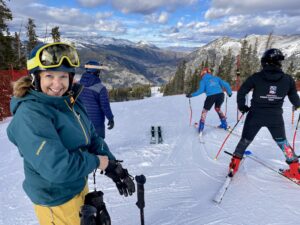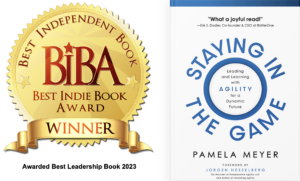
Abbie More, Product Group Manager, Friesland Campina and Level 3 PSIA Ski Instructor
In Staying in the Game: Leading and Learning with Agility for a Dynamic Future, I share the lessons I learned from some of the world’s most agile leaders across sectors. Based on this work, I introduced a new type of leadership: Embodied Agile Leadership. Embodied Agile Leaders (EALs) embody the values and practices of agile leadership and are attuned to their bodies and environment as a source of agile learning feedback, energy, and resiliency.
In this month’s spotlight, I shine a light on Abbie More, a leader in another dynamic industry that depends on Embodied Agile Leaders at all levels to adapt and innovate in response to constant change. I also draw from a few brief excerpts from Staying in the Game while sharing some of Abbie’s inspiring, actionable insights. I’ve been lucky to learn from Abbie’s wisdom on and off the mountain over the last several years. Through countless conversations on chairlifts and après ski beverages, training camp meetings, and Zoom calls, we have explored how the mountain is sometimes more than just a metaphor for the unpredictable terrain in business.
To be effective in an ever-changing landscape and ready for a dynamic future, EALs have learned to shift from planning to preparing.
As Product Group Manager at Netherlands-based FrieslandCampina Ingredients, Abbie More has made this shift throughout her career. In addition to leading a cross-functional team of scientists and product specialists in an ever-evolving arena, Abbie taps her experience moving through to the highest ranks of professional ski instructing and race coaching. The goal in both, she discovered, is not to ignore or be without fear when the stakes are high. She shared, “I have had several instances in my ski life when I’ve been terrified.”
The key is to realistically assess the barrier and transform it into an opportunity. Abbie had a breakthrough at the top of a particularly challenging run that has guided her success ever since. While trying out for the Development Team of the Professional Ski Instructors of America, the next level for advanced instructors, she shared: “I saw a catwalk, and I thought,
“I could just bail. This is too scary. This is too hard for me. What if I can’t ski? What if I can’t turn my feet? Let me just do that. Let me just take the easy way down, and we’ll forget this ever happened.” Then I said, “Yeah, right, and you look at yourself in the mirror tomorrow morning, and you’ll be really disappointed. Just stop it and do it.” I did, and nothing bad happened to me. I had an awesome run. I felt great about it. I got really good feedback, so I try and remind myself of challenging points like that when something was scary to me. It was a risk. Yeah, I had to put myself out there that day. Seven or eight examiners had their little cards in their hands, and they were watching me and taking notes. They were watching my every move, and I had to challenge myself to make a shift. Your head wants to say, “They’re going to watch for mistakes.” But I was able to turn that around and say, “They’re going to watch for your good movements.”
Assessing the situation through embodied reflection and shifting her mindset has translated into Abbie’s leadership role. For example, when she delivers her quarterly report to the global organization, Abbie reminds herself, “You got this. You know what you’re doing. They’re not looking to you for mistakes. They’re looking to you for information to help the organization. Just drawing from those experiences, turning my mindset around has really, really helped me get through some hard things, some challenging things.”

Abbie More Practices Continuous Improvement on and Off the Mountain
Embodied Awareness and Reflection
For EALs like Abbie, embodied reflection means going beyond cognitive awareness and understanding. It is rooted in attunement to what is happening in the body and discerning the messages found there. For this reason, embodied reflection starts with embodied awareness. With awareness, we can learn and adapt to our current reality, often in the present moment. For example, if you have ever presented in front of a group and become aware of your mouth getting dry, your face flushing, and perhaps speaking so quickly you are running out of breath, you have experienced embodied awareness. With embodied reflection, you might have chosen to pause, catch your breath, and take a sip of water to regroup and reconnect with yourself and your audience. Without embodied awareness or reflection, you might have found yourself ignoring these signals and motoring on, missing the opportunity to make intentional shifts.
Embodied reflection can be especially helpful for EALs who are leading with learning and have an intention or outcome in mind. Intentionality provides a focus so they can translate their embodied reflection into specific action, whether it be going faster, engaging an audience, or improving business results.
Agility and Action Through Embodied Awareness
Abbie’s experience on the mountain and leading her team demonstrates that we don’t need to be hijacked by our nervous system’s well-meaning but clumsy attempts to preserve our safety. With self-awareness, we can recognize the signs of negativity bias and intentionally shift to overcome it. The first step is being mindful of and understanding our embodied experience in high-stress situations or even as we anticipate venturing from the safety of our familiar surroundings for a new challenge or opportunity. Persevering also means not waiting for someone else to inspire or motivate you. Abbie More shared, “In business, you have to take responsibility. If you have a challenge in business, if there’s an account you just can’t get into, take ownership of it. Don’t sit back and say, ‘Well, they won’t take my calls.’ Figure out how to make it happen.”
Embodying an Agile Mindset
Mindset plays a critical role in fostering and inspiring strength and resiliency. Abbie shared how she carries her agile mindset and mental toughness from her regular morning workouts into her workplace for strength and resiliency.
Two of my workouts are circuit classes with ten stations set up, and we do five rounds. It’s 30 seconds of work at each station and 30 seconds of rest. I have a friend who comes to these who’s a retired state trooper. He will typically be at the station right next to me, so either I follow him or he follows me. Besides all the banter back and forth, it’s funny because we’ll get to a station, and maybe there’s a burpee station or another tough station. Whatever the station is, he approaches it like, “Ugh, I gotta go do this one.” I’m like, “Really? That’s my favorite!” I remember one the first times we did this. He’d get to each station and say, “Oh, I have to go to this station.” I was like, “That’s my favorite!” All the way around. Suddenly he looked at me, and says, “I know what you’re doing.” I said, “You have to make each of them your favorite. You have to look at them as, ‘I’m going to have fun here. I have to have fun for only 30 seconds, and I’m going to make the best of it.’” Let’s face it, do you really think burpees are fun? Nobody does, but if you tell yourself, “This is my favorite. I am going to have fun with it,” then you can find something positive about it. It’s the same with work. “Hey, I have a challenging issue ahead of me. It’s stuff I really don’t like dealing with. It’s not sexy. It’s not fun. But it’s necessary. I’m going to make it my favorite, too.
Abbie describes the kind of intentional mindset shifting as the hallmark of EALs who can stay strong and resilient. Rather than give in to the first impulse to resist tough challenges or simply “get through them,” EALs actively choose a positive mindset and find the opportunity within them. By doing so, they find and create energy rather than become unnecessarily depleted. This is why people love working with (and working out next to) EALs! And who knows, maybe you will learn to love the burpees in your day, too.
The Value of Holding Your Goals Lightly
I recently caught up with Abbie on the slopes of Colorado to hear her latest insights. In our first conversation, she shared lessons she has learned about holding your goals lightly — on and off the mountain:
With an agile mindset and a readiness to adapt to improve results and generate more value, leaders like Abbie More inspire us to lead and learn with agility when conditions change.
READ MORE ways Abbie More and other Embodied Agile Leaders from across industries lead and learn with agility for a dynamic future in Staying in the Game: Leading and Learning with Agility for a Dynamic Future. Now Available on Audible!

FOLLOW Pamela on LinkedIn and read the original post here.
